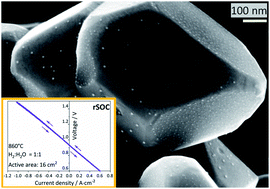A-site deficient chromite with in situ Ni exsolution as a fuel electrode for solid oxide cells (SOCs)†
Abstract
A-site deficient lanthanum strontium chromite perovskite La0.65Sr0.3Cr0.85Ni0.15O3−δ (L65SCrN) decorated by in situ exsolution of Ni nanoparticles was synthesized and implemented as a fuel electrode on a 5 cm × 5 cm electrolyte-supported cell (ESC) for solid oxide cells (SOCs) with an active surface of 16 cm2. The stoichiometric formulation La0.70Sr0.3Cr0.85Ni0.15O3−δ (L70SCrN) was also prepared in order to evaluate the reducibility and behavior towards Ni exsolution with respect to L65SCrN. This comparison was assessed by means of X-ray diffraction (XRD) and thermogravimetric analysis (TGA) in a reducing atmosphere. Metallic Ni was successfully detected using XRD on the A-site deficient formulation after TGA treatment. Surface analysis by means of X-ray photoemission spectroscopy (XPS) revealed a relative enrichment in Cr3+. Ni exsolution was investigated on the L65SCrN formulation by annealing in a reducing atmosphere at 500 °C and 900 °C for 3 hours. The Ni nanoparticle size (from ∼8 up to 100 nm) and morphology were characterized by means of scanning electron microscopy (SEM). Furthermore, L65SCrN was screen printed onto a 90 µm thick CGO20-3YSZ-CGO20 electrolyte on which the oxygen electrode La0.58Sr0.4Fe0.8Co0.2O3−δ (LSCF) was printed on the other side. With ideal contacting, the electrochemical cell performance of the L65SCrN fuel electrode was demonstrated to be comparable to those of the state-of-the-art Ni-based cermets: ASRDC_Total at −0.3 A cm−2 was calculated to be 0.676 Ω cm2 in co-electrolysis operation. Reversible operation (rSOC) at 860 °C with a H2O/H2 ratio of 1 could be shown and co-electrolysis operation (H2O/CO2 = 2) at −0.45 A cm−2 and 860 °C with a voltage degradation of less than 3.5 mV/1000 hours could be demonstrated for 950 hours. Even though L65SCrN showed promising results for SOC operation, further investigations of Ni exsolution in doped chromites by varying temperature, time and pO2 are proposed for a detailed understanding and optimization of the Ni nanoparticle size.



 Please wait while we load your content...
Please wait while we load your content...